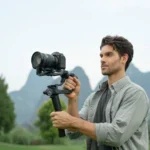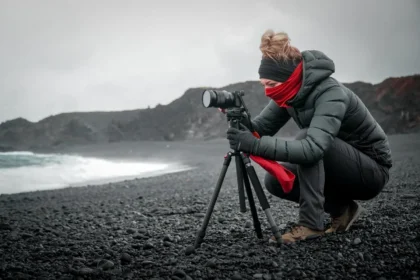A reliable tripod is one of the most essential tools in any studio photographer’s setup. Whether you focus on portrait shoots, product photography, food styling, or high-end commercial work, a tripod provides the stability and precision needed for sharp, consistent, and professional results. The right tripod can help maintain perfect angles, support heavy camera setups, and enhance workflow efficiency in the studio. Here are five professional tripods that every serious studio photographer should consider.
- Why Every Studio Photographer Needs a Professional Tripod
- What to Look for in a Studio Tripod
- 5 Professional Tripods Every Studio Photographer Needs
- 1. Heavy-Duty Studio Tripod for Precision Shoots
- Key Benefits
- 2. Carbon Fiber Tripod for Vibration-Free Results
- Key Benefits
- 3. Tripod with Geared Head for Professional Control
- Key Benefits
- 4. Studio Tripod with 3-Way Pan Head
- Key Benefits
- 5. Compact Tabletop Tripod for Product and Macro Photography
- Key Benefits
- Comparison Table of Studio Tripods
- Tips for Choosing the Right Tripod for Your Studio
- FAQs About Professional Studio Tripods
Why Every Studio Photographer Needs a Professional Tripod
Unlike handheld shooting, studio photography demands control. A tripod allows photographers to lock in composition, maintain consistent framing, and shoot at lower shutter speeds without sacrificing quality. This is especially useful when working with controlled lighting, detailed subjects, or long exposure techniques. Tripods also make it easier to adjust lighting, add accessories, and refine the scene without constantly repositioning the camera.
What to Look for in a Studio Tripod
Before exploring the top options, it helps to understand the key features that define a professional-grade tripod designed for studio use.
Load Capacity
Studio cameras often include heavy lenses, flashes, and accessories. A tripod with a strong load capacity ensures stability even with large or top-heavy setups.
Build Material
Aluminum and carbon fiber are the two most common materials. Aluminum offers durability and cost-effectiveness, while carbon fiber is lightweight and absorbs vibrations well.
Height Adjustment
Studio setups vary widely, and a tripod must accommodate everything from tabletop product shoots to full-body portraits.
Head Type
Ball heads offer flexibility, while 3-way pan-tilt heads provide precise adjustments. Some studio photographers prefer geared heads for ultra-fine positioning.
Stability
Studio tripods often come with rubber feet, weight hooks, and thicker legs to ensure movement-free operation on smooth indoor surfaces.
5 Professional Tripods Every Studio Photographer Needs
1. Heavy-Duty Studio Tripod for Precision Shoots
For photographers who need controlled, repeatable compositions, a heavy-duty studio tripod is the most reliable option. These tripods often feature wide leg structures, center columns with adjustable tension, and high load capacities. They are ideal for product photography, macro work, and detailed portrait sessions where stability is paramount.
Key Benefits
- High weight support for professional cameras
- Stable design ideal for long exposure shots
- Smooth center column movement for micro-adjustments
This type of tripod allows photographers to maintain consistency between shots, which is essential for commercial product catalogs, e-commerce shoots, and client work that requires uniformity.
2. Carbon Fiber Tripod for Vibration-Free Results
Carbon fiber tripods are preferred by many studio professionals due to their strength and vibration absorption capabilities. They are lighter than aluminum, yet extremely sturdy, making them perfect for photographers who want a stable but portable option within a studio environment.
Key Benefits
- Lightweight yet highly durable
- Reduces vibration for sharper images
- Easy to reposition during multi-angle studio shoots
These tripods are particularly useful in studios where the floor may not be perfectly solid or where multiple light stands and modifiers create micro-vibrations.
3. Tripod with Geared Head for Professional Control
A geared head tripod is a game-changer for studio photographers who demand precision. Unlike ball heads that rely on free movement, geared heads use controlled knobs that allow micro-adjustments in all axes. This is ideal for architecture-style product photography, food layouts, and artistic compositions requiring exact symmetry.
Key Benefits
- Fine-tuned adjustments for perfect framing
- Highly stable for high-resolution cameras
- Excellent for tabletop, macro, and product shoots
Geared head systems are widely used in commercial studios for their ability to maintain consistent angles across multiple shots.
4. Studio Tripod with 3-Way Pan Head
A tripod featuring a 3-way pan head offers another level of precise control without the mechanical gearing. These heads allow individual adjustments for vertical, horizontal, and tilt movements, making them extremely versatile for portrait and lifestyle studio sessions.
Key Benefits
- Separate movement controls for flexibility
- Smooth panning and tilting for video or hybrid creators
- Easy to adjust while maintaining camera stability
This is one of the most versatile tripod styles, suitable for both photography and content creation setups inside a studio.
5. Compact Tabletop Tripod for Product and Macro Photography
A studio is not complete without a tabletop tripod. These compact tripods are essential for shooting smaller products, close-up details, jewelry, electronics, or food items. They fit easily on shooting tables and offer excellent stability for lightweight and mid-range camera setups.
Key Benefits
- Small and portable for tight studio spaces
- Ideal for macro and top-down photography
- Perfect for social media content creation where multiple angles are needed
Many photographers use tabletop tripods for overhead flat-lay shots, which are extremely popular in product and lifestyle photography.
Comparison Table of Studio Tripods
| Tripod Type | Best For | Key Strength | Ideal Use |
|---|---|---|---|
| Heavy-Duty Studio Tripod | Large cameras, long exposure | Maximum stability | Product shoots and portraits |
| Carbon Fiber Tripod | Vibration control | Lightweight, strong | Multi-angle studio shooting |
| Geared Head Tripod | Precision framing | Micro-adjustments | Commercial and macro photography |
| 3-Way Pan Head Tripod | Versatility | Smooth movement | Portrait and hybrid photo/video |
| Tabletop Tripod | Small subjects | Compact design | Product, jewelry, and flat-lay shots |
Tips for Choosing the Right Tripod for Your Studio
Match the Load Capacity to Your Gear
Always choose a tripod with at least 25 to 30 percent more load capacity than your heaviest camera setup.
Consider Your Shooting Style
Portrait photographers may prioritize flexibility, while product photographers need precision and stability.
Ensure Compatibility with Accessories
Your tripod should work well with mounts, lighting arms, sliders, and stabilizers used in studio environments.
Choose a Durable Build
Studio equipment is used frequently, so a rugged build material ensures longevity.
FAQs About Professional Studio Tripods
What makes a tripod suitable for studio photography?
A tripod designed for studio use typically has a high load capacity, minimal vibration, precise controls, and stable legs. These features help maintain consistent framing and perfect angles during controlled shoots.
Do studio photographers need more than one tripod?
Yes. Many professionals use a standard heavy-duty tripod for portrait sessions and a smaller tabletop tripod for product or macro photography. Different tasks demand different levels of height, stability, and control.
Are carbon fiber tripods better for studio use?
They offer excellent vibration resistance and are easier to move around the studio. However, aluminum models can provide equal stability at a lower cost.
Should I choose a ball head or a geared head for my studio tripod?
A ball head offers speed and flexibility, while a geared head provides precision. For product or commercial work, geared heads are preferred. For portraits and general studio work, ball or 3-way heads are ideal.
How tall should a studio tripod be?
Most studio photographers prefer tripods ranging from 55 to 70 inches in height, allowing comfortable operation for standing and seated shoots.




